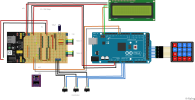hi
i am working on a project that includes 3 stepper motors with an L298n driver for each motor.
i am connecting all motors to a external power supply 12v - 3A.
what i get is that if i move 1 stepper motor it works fine if i try to move another one arduino is shutting down and again on.
and again if i move another stepper motor it works fine as long as i try to move the second motor it shuts down and again on (light gets dim and again normal) so my first thinking was
there is not enough current flowing so i wanted to order a 12v - 5A power supply but i have another power supply where i can set the voltage
this one:

 www.aliexpress.com
www.aliexpress.com
it is a 3-24v with 3A power supply.
so i tried to set a lower voltage and to my surprise if i set between 6-7 volt i can move all 3 stepper motors if i set lower then 6 or higher then 7 again it shuts down if i try to move more then 1 stepper motor.
why is it like that? is it the arudino that shuts down the motors because the high amperage?
i know that the motors can run with 12 volts and the l298 also so i don't think it is the voltage that makes the problem i think the 3A is to high. am i right?
should i try a 12v with 2A?
this is the stepper motor i use:

 www.aliexpress.com
www.aliexpress.com
and this is the l298n driver:

 www.aliexpress.com
www.aliexpress.com
thanx
i am working on a project that includes 3 stepper motors with an L298n driver for each motor.
i am connecting all motors to a external power supply 12v - 3A.
what i get is that if i move 1 stepper motor it works fine if i try to move another one arduino is shutting down and again on.
and again if i move another stepper motor it works fine as long as i try to move the second motor it shuts down and again on (light gets dim and again normal) so my first thinking was
there is not enough current flowing so i wanted to order a 12v - 5A power supply but i have another power supply where i can set the voltage
this one:

10.51US $ 36% OFF|Universal Charger Power Supply Adapter 5v 12v 24v 36v Ac Dc Transformer Converter 220v To 12v 5v 24v Led Power Supply Adjustable - Ac/dc Adapters - AliExpress
Smarter Shopping, Better Living! Aliexpress.com
it is a 3-24v with 3A power supply.
so i tried to set a lower voltage and to my surprise if i set between 6-7 volt i can move all 3 stepper motors if i set lower then 6 or higher then 7 again it shuts down if i try to move more then 1 stepper motor.
why is it like that? is it the arudino that shuts down the motors because the high amperage?
i know that the motors can run with 12 volts and the l298 also so i don't think it is the voltage that makes the problem i think the 3A is to high. am i right?
should i try a 12v with 2A?
this is the stepper motor i use:

9.79US $ 36% OFF|Cloudray Nema 17 Stepper Motor 42ncm 1.7a 2 Phase 40mm Stepper Motor 4-lead For 3d Printer Cnc Engraving Milling Machine - Stepper Motor - AliExpress
Smarter Shopping, Better Living! Aliexpress.com
and this is the l298n driver:

1.28US $ 5% OFF|L298n Motor Driver Controller Board L298 Module For Arduino Dual H Bridge Dc Stepper Motor Smart Car Robot - Integrated Circuits - AliExpress
Smarter Shopping, Better Living! Aliexpress.com
thanx
Last edited:

